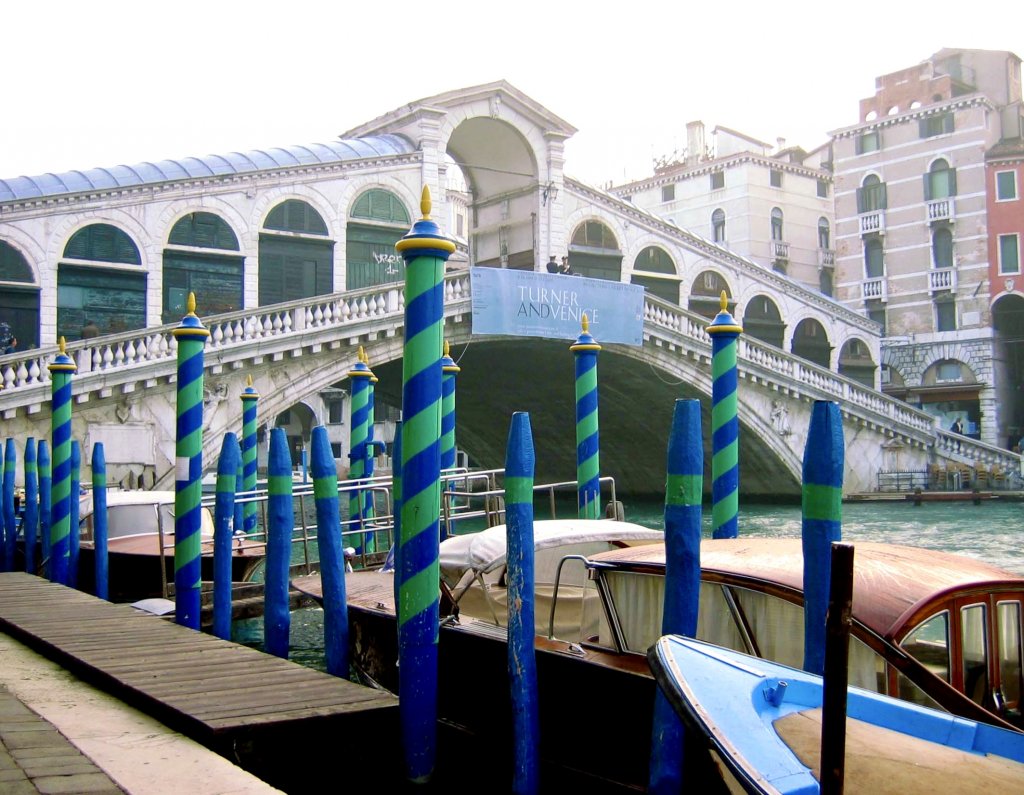Before visiting Venice in 2004, I studied guidebooks to learn the Vaporetto routes and the location of the churches and museums. I packed a map with all of the calles, campos and palazzos noted, confident that I’d be able to navigate my way around the city.
I had my map, but no idea where I stood on it. As I walked across my campo, I turned right onto a narrow calle that quickly became a dead end. I backtracked until I found a fork that led into another campo, this one with vine covered brick walls and fluttering laundry dancing from the windows. I crossed over an arched bridge and found myself in an open space where a produce cart was doing a brisk business.

With fig juice dripping down my chin, I tried to retrace my steps but I had no idea where my home was.
Running into more dead ends, I stumbled onto the vine-covered campo with the laundry and realized my home was close by.
At least I wasn’t lost. My recurring nightmares feature winding staircases leading nowhere and identical rows of houses whose doors I try to open with a key that never fits.
The next day, I decided to write down the names of every major campo, calle, palazzo, church and business I passed. I couldn’t get lost.
My goal was to find the Rialto Bridge, which was supposed to be ten minutes away.

I recorded Calle Widman, a red brick passageway, no more than three feet across. Then the Church of Santa Maria dei Miracoli with its façade constructed of subtly differing shades of marble and finally the Campo S. Bartolomeo, a bustling square where green canvas umbrellas protected diners from the hot sun.
Soon I came to a sign that said “Rialto” with two arrows. One pointing left. And one pointing right.
I felt like Dorothy in the Wizard of Oz after she met the scarecrow.
I did a mental coin toss and left won. After winding through a maze-like detour, I emerged, facing the grand canal with massive steps leading to the crowds on the Rialto Bridge.

Though forty-five minutes had passed, I could see where I was on my map and I had a list of landmarks to get me home, a modern alternative to leaving a trail of breadcrumbs.
I could now enjoy the delights of the Rialto market.

“Macelleria Equina” was a butcher shop that sold only horsemeat, an Italian delicacy eaten on special occasions. Their window displayed sausages, patties, steaks, roasts and other cuts of meat I couldn’t identify.

Next, I was looking into the beady eyes of translucent salmon-colored eels with their mouths were curled in dopey grins.
As the light began to fade, I opened my notebook to begin the journey home. But few of my landmarks made sense. “Del Vino Rossa,” a wine store that I’d recorded earlier, had simply vanished. Only later did I realize that businesses in Venice had their names painted on the window glass. When they closed, a metal shutter was rolled down, hiding the window from view until they re-opened.
I recognized a square by its name, “Campo SS Apostoli,” but had no idea what direction to go. Everything looked familiar. I’d walked through this square before; I remembered a gelato shop displaying its flavors like an artist’s pastel palette.
I had been walking in a large circle which explained my deja vu. By bravely exploring new alleys and passageways I tried to escape the medieval merry go round.
Panic was lurking, just out of reach.
I sat down on the side of a stone cistern in the Campo Santa Maria Formosa. Deep breaths, in and out. In and out. It was ridiculous to worry about being lost in Venice.

It was time to trust my instincts to see if my unconscious mind could take over. My intellect had failed at solving the problem and I’d run out of other ideas.
It was my body’s turn to lead. After a while, it became more and more enjoyable.
All recognizable landmarks had been replaced with the unknown but I wasn’t alarmed.
Every building was bathed in syrupy light, as if viewed through the petals of buttercups. Every canal competed as a candidate for a postcard home.
The geraniums on a balcony were the exact shade of peach to match the filmy blouse dancing in the breeze.
I was basking in the mystery of Venice.

Venetians in their well-cut clothes were proudly strolling through their city, as they had for centuries, greeting each other as neighbors and fellow actors on a surreal stage.
I was now part of this parade, at peace with yesterday as I embraced the present. Medieval walls disclosed their ancient doors, that when opened, juxtaposed the centuries. This may have been the estate of a noble family, but today, a modern athletic club stands behind the walls. Families gather here at the end of the workday, part of today, but forever linked to the past, simply by breathing the air and allowing their feet to rub the well-worn cobblestones.
When I let go and allowed myself to be part of Venice, I discovered a new sense of home.
